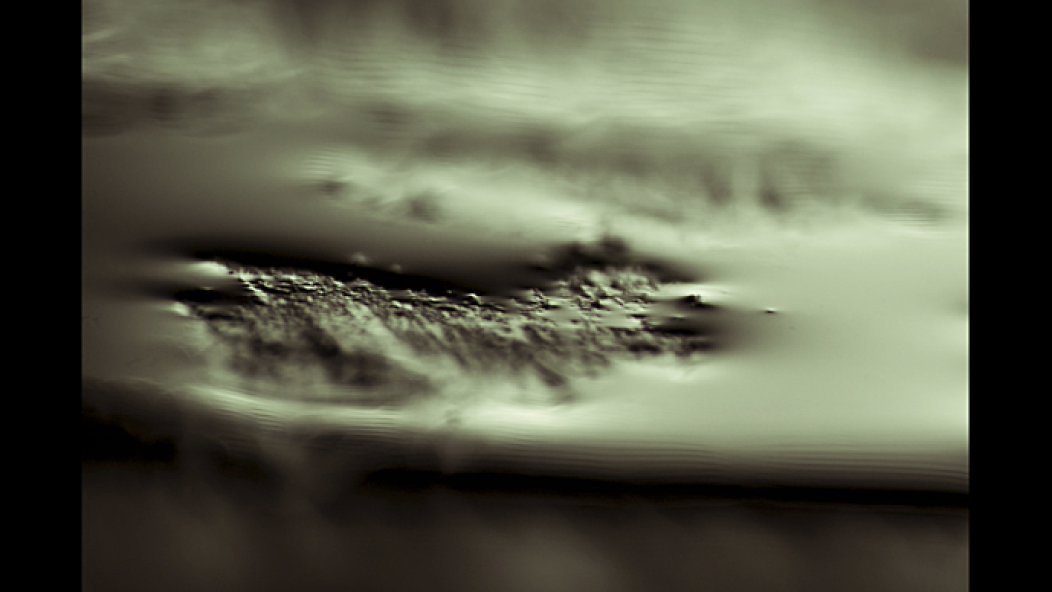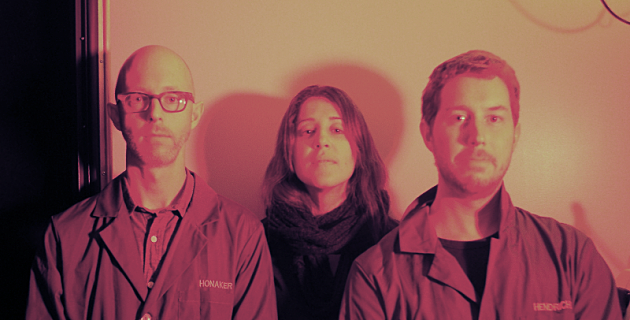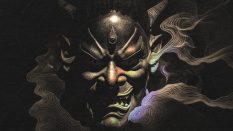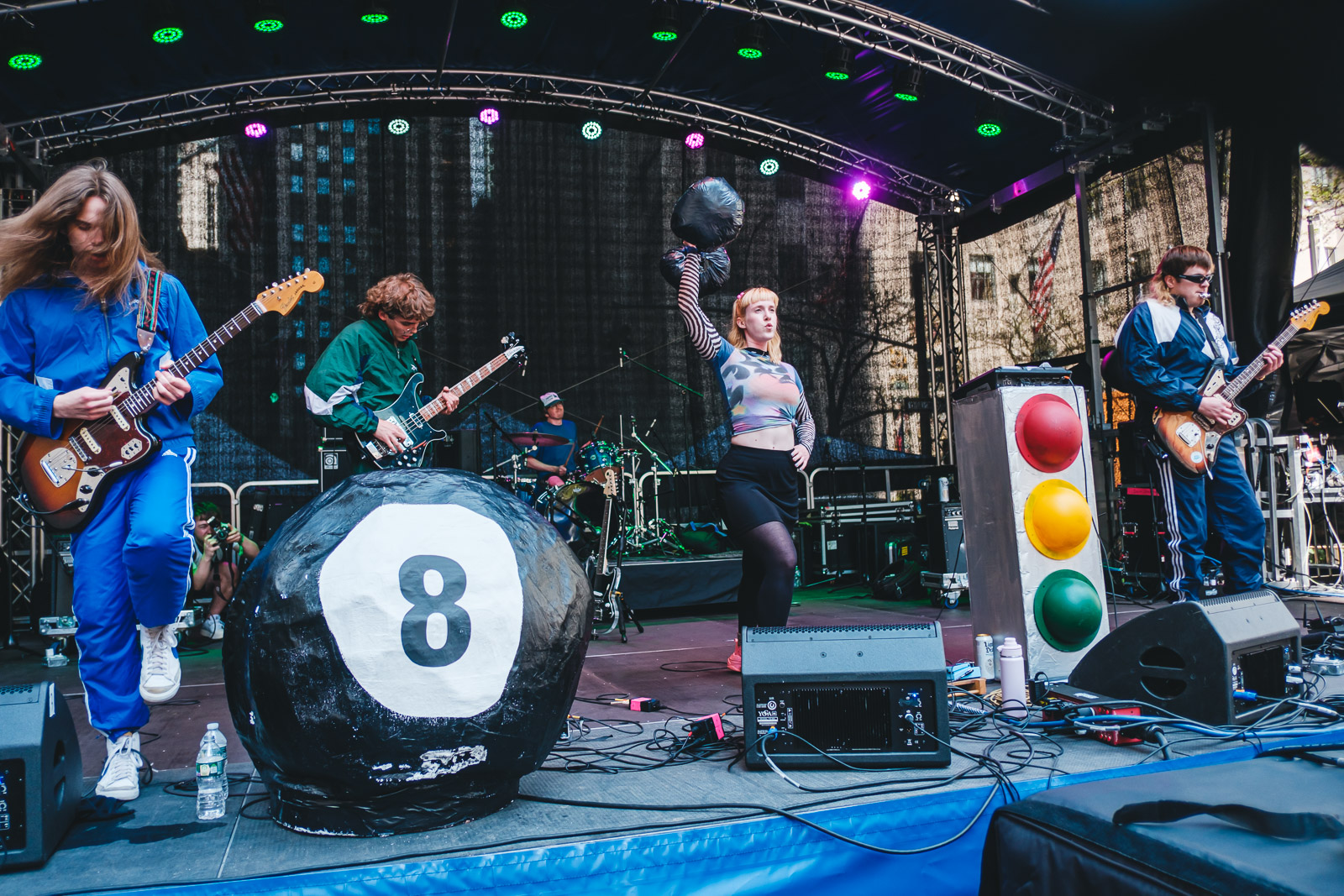
Ionophore: When a Metalhead and Two Scientists make Electronica

…
As an electronics nerd, my workflow for any project is made up of two questions: “How can I get from point A to point B? Can I do it using the tools I currently have?” For rock and metal bands, they have the voice, guitar, bass guitar and drums. Those like Tristan Shone of Author & Punisher can build their own tools. Still though, some ideas that artists hear in their head can’t manifest themselves through rock band instrumentation, or even Shone’s valve-piston-puncher-thingy. Sometimes you need a đàn bầu, or a digital synth or two.
Leila Abdul-Rauf cemented her reputation with death metal bands Saros and Vastum, but she continues to express a different part of her mind through an electronic outfit called Ionophore. With scientists Ryan Honaker and Jan Hendrich complementing Rauf’s voice and horns with beats, synths and other analog/digital twists, Ionophore’s second album Sinter Pools opens with a sci-fi horror movie soundtrack. Specifically, the title track would play after the space station gets hit by an alien asteroid and the astronauts have to explore a wrecked, poorly illuminated hallway before being eaten by a creature with five arms and no legs. The creepiness neighbors Ennio Morricone-esque trumpet lines, ambient strolls, dance beats and even the occasional robo-Rauf vocal. Sinter Pools is a trip to say the least, its moods and styles never give you an opportunity to doze off.
Sinter Pools is set for release on March 1 via Malignant Records. You can stream the record in its entirety below.
…
…
Ryan, is the name Ionophore at all related to your microbiology work at Stanford University? Are you ever able to draw creative inspiration from your academic work?
Ryan: You know, I honestly can’t remember who came up with it—although I have used ionophores before in the lab). Jan is actually a scientist as well, randomly enough, he was a postdoctoral fellow at University of California, San Francisco, but we randomly met via the musicians’ section—not the personals or scientists section, surprisingly—on Craigslist. There are definitely some sciencey song names on the first album as well. I think actually Leila may have proposed this name and we all liked it—and I actually heard it in a talk a few days later, seemed like a sign.
As for science inspiration, the cover art for the first album is something Jan grew in the lab then photographed, but for me personally, it’s an interesting question that I’ve actually thought a lot about over the years. While I don’t think there’s necessarily a direct inspirational link, I think being involved so intimately with science for so long changes the way you think in a lot of ways, and I’m positive that it translates into the way I think about composition, tone, engineering, etc. The fundamental nature of being a scientist is analytical thinking, which may seem contrary to creativity, but in reality there’s a huge amount of creativity used in problem solving.
Can you think of any specific examples with either of the records on how you used the analytical side of your mind to solve a musical problem?
Ryan: I sort of have a hybrid approach to the way I think about writing in most of the songs I contribute to in any significant way, an analytical component followed by creating a musical solution. I sort of conceptualize songs in general as having sort of naturally-occurring limits in the amount and type of musical information it can contain. Thus as a song is being composed multiple analytical problems arise. The first is the identification of sonic gaps that can—and also should, you don’t want every possibility covered all the time otherwise there is no dynamic—be filled. Then you imagine what type of element you want to add that adds musical and compositional value. There’s most frequently not one single answer to this question to me, which then brings up the next problem to analyze and solve, which is then how to attain, produce, and record something that satisfactorily complements the song, filling in the missing information. This is probably the way everybody does it, but I definitely sort of view it as musical problem with many solutions. And I don’t know, maybe I think about how I think about it more than the average person because I’m a scientist and can’t help it.
For example in “Post” I wanted to have a song with some melodic elements, but I didn’t want it to sound like a particular instrument—in fact many times I want it to not sound like a traditional element—but I wanted it to fulfill the role of a melodic chord progression in the song. So I wrote the part on guitar and then tweaked it a bunch of ways until there was something I was happy with. Then I put it up and let Jan and Leila go to town on it. Regardless of what type of part is there, I’ll think there’s room and a need for something, but not having the limitations of traditional instrumentation, and having production capabilities, there are an infinite amount of ways to get to the answer. An another example would be in “Infantman,” during the middle part where there’s the weird sort of tuned ambient bit. I thought the song should have a second sort of part, but only had a sort of tone in mind for it, including wanting some sort of progression. So I took the reverb tail from one of the other tracks that had really great tonal and atonal components and made a sampler out of it so I could play different notes with it.
Leila, metal songwriting often begins with a riff, but where does the genesis of an electronic song come from for you?
Leila: With the kind of music we make, the compositional possibilities are seemingly endless. An initial idea could come from just a tone, a rhythm, or even just a texture. Sometimes I hear “notes” in a noise track, and from there, come up with a vocal melody or trumpet line. Sometimes the beats and rhythms are built from a texture, or vice versa. There isn’t a single formula to it. Unlike writing a metal song, which is for the most part a very linear process—i.e. stringing riff after riff together—our compositional process is much more dynamic and layered, especially since everyone in the band is a multi-instrumentalist, songwriter and producer. Our songs also span the continuum of stripped down and simple to more complex, so there is great variety from track to track.
The songwriting for this record was different from the last album in that Jan is now remote, located in England instead of California. How did Jan’s absence affect the composition of the record? How does a band where every member’s roles can potentially overlap go about writing songs?
Jan: I’m not sure if has changed things all that much in terms of writing. The majority of songs were already in place conceptually, and the remainder just fell into place. For me, writing in Ionophore has been really novel in that we all have access to a track—shared over the internet—with the understanding that anyone can take any element of the music and develop it further. While I greatly miss the ability to meet up together and chat about the songs, the writing process hasn’t changed all that much.
Ryan: I don’t think the writing really changed too much. Initially when we started the project we were going to be a studio project only—because Leila was in a dozen bands—and so we started writing in an interesting way, sort of coming up with rough ideas and tossing them up into a shared folder. Then you’d hear something that would inspire you and you’d work on it for a bit and put it back up. It ended up being a really interesting, collaborative and inspirational way to work. And I really liked the fact that everyone is a multi-instrumentalist and has production chops, because you’re not tied down to writing X part for Y song, you can write whatever you feel like for whichever song, and change the structure or composition of the song to include the additions. The other thing that was really nice, and made it work, was that nobody has any ego about it, so any changes or input on any of the parts was always given and received in a way where everyone knew that everybody had the best intentions for the song. But we sort of established a method and rhythm to the writing which we liked, and which luckily didn’t have to change when Jan moved.
Leila: Most of the Sinter Pools album was actually written and recorded prior to Jan moving back to London, right before doing a brief Pacific Northwest tour, so we have already had a chance to perform some of the material live. As much as I miss getting together for a live practice and playing shows, I enjoy the fact that we have the ability and flexibility to keep the band going regardless of our geographical location. Because our writing process since the beginning is mostly done on home computers, band members moving doesn’t affect our writing process much. And since all three members are up for traveling, whipping up a live set for a performance is still within our realm of capability given the right time and opportunity, on either side of the pond.
How do the arrangements of these tracks change live, and what goes on in the decision-making process behind it? What kind of compromises—if any—need to be made to the number of instruments and sounds offered? Does a band like Ionophore go through a normal band rehearsal process before playing live, or is there a different workflow?
Leila: We use a combination of pre-recorded loops, live performances, and live capturing of those performances—manipulated samples of what we play live. This aspect builds in an improv element to our set. There are so many layers to a recorded song that it’s impossible to completely mimic it live. I prefer to think of the recording and the performance as two separate animals. That way we have a lot of freedom in making each as good as it can be without having to adhere to an exact replica of the recording. That said, the beginning of our rehearsal process for a live show brings unique challenges and involve a lot of trial error: some songs work well live, and others don’t, and deciding which are which can take time and patience. Most of the time it’s the songs that work in a more stripped down form without having to include all the layers that work best live. Sometimes we only perform sections of songs and connect them with improv sections. Or we might transform a recorded track entirely and maintain only a small recognizable element of it when playing it live.
I think the process of going live is one that we’ve improved on over the years especially after being on tour; as we’ve gotten more familiar with each other’s sounds, we can read each other better and improv more seamlessly off of one another. We also have an unreleased recording of our live set from 2013, which includes tracks from both albums, a 50 minute block of music unfolding in kind of a stream-of-consciousness way.
Ryan: Leila summed it up beautifully. I would just add that I think we do go through a regular rehearsal process eventually. But only after the added and very significant step of translation from the recorded version of the song that we wrote to the mechanisms for playing it live. And as Leila alluded, it’s a really interesting and creatively demanding problem, but can also be a frustrating one. Some songs translate similarly to the recordings, some end up quite different, and some we can’t figure out a way to do that is interesting and we’re happy with.
Jan: This part, for me, is like writing a new album. When writing a track you end up committing to the idea of these blocks of sound stuck together, and then you add a load of cool stuff in between. When we adapt tracks for live performance, we get to dissect all these blocks apart and start again!
…

…
Ionophore’s music contains both “real” instruments such as voice, piano and trumpet, as well as entirely synthesized beats. In what context does it make sense to utilize an electronic track as opposed to a live instrument and vice versa?
Jan: Our choice of instrument depends on the context. We all play a few instruments, and often we reach for one during the early stages of writing. This can then be a springboard for any amount of manipulation or sampling. It also doesn’t hurt that Ryan and Leila make such great sounds with the violin and trumpet to begin with! There is a desire to take these instruments somewhere sonically interesting, which is usually where the electronic manipulation comes in.
Ryan: Many of the synthesized beats, or textural/ambient/droney elements are actually composed from real instruments as the tonal source. I think that’s one thing that’s interesting about our musical backgrounds – we all grew up playing regular instruments in school and bands, and then started wanting to push the envelope and see what else we could do with them. We’ll do things like make a homemade soft synth from a looped violin part, or make a kick drum from a chunk of guitar feedback. It’s the synthesis and overlap between organic and production that I think is part of what we think is interesting and are exploring.
Leila: I don’t overthink this, but I’m less involved in the beat making, so it’s simpler for me. With the exception of synth patches or other occasional sound presets, I’m using “real” acoustic instruments which are usually heavily processed or altered in some way.
Ryan, on the last record, you played a Đàn bầu. Is that instrument featured at all on the new record, and are there any other out of the box instruments that can be spotted? What was your background in learning these instruments?
Ryan: The Đàn bầu is on there in some of the noisy elements. I was traveling in Vietnam and stumbled into an instrument shop in Hanoi and was looking around. I’d seen a couple of them played and thought they were really interesting, but they’re pretty big, and I figured there’d be no way to get one home. In the shop I saw one and was looking at it, and the guy who ran the shop came over and—first victory on his part—plugged it into an amp, then showed me how to play it. It’s a one-stringed instrument, and with a pick you pluck with your right hand, the palm of which is hitting a harmonic, so you pluck and lift to let it ring. The left hand bends a flexible sort of stick, which shifts the pitch. It was really fun, and pretty simple to figure out. But the thing was still pretty long—although shorter than those I’d seen—and the guy won his second and final victory by showing me that this one actually had a hinge, so it folded in half, and came with a bag, and I was sold. I basically learned to play it by experimentation and watching YouTube videos. There’s this guy on there who’s like the Van Halen of Đàn bầu players, it’s pretty amazing. Running it through all sorts of interesting effects just made it more interesting.
As far as other weird instruments, we definitely have sampled weird stuff, or put contact mikes in unusual places, or play instruments in unusual ways, and build textural or rhythmic elements out of them. For example on “Underground Man,” the rhythmic loop is from the pickup on my violin, which I was sort of scraping and tapping and eventually turned it into the loop you hear at the beginning. On the same track there’s this sort of scratchy delayed effect that was from a faulty cord when Jan was recording something but which we liked and so it became a rhythmic element as well.
How does composing electronic music intersect with audio engineering, if at all? Is there a challenge in having a wider palette of tones to choose from and paint your songs with compared to the traditional rock band format?
Jan: I think that there is a challenge, and represents a big difference. For example, a guitarist will obsess over which guitar/amp/effects to use to strive for the perfect tone, in the knowledge that the other band members have the bass and drums sorted. The electronic musician, on the other hand, perhaps has greater control over sounds—everything can be tweaked or engineered—but also a responsibility to make the whole thing sit together as a song. Having said that, I don’t think any of us agonise too much when designing an effect rack or type of synth. It’s quite easy to arrive at the correct sound when you know what you’re aiming for.
Ryan: I think there’s definitely a big intersection. Very rarely are you ever just tracking a straightforward instrument, there’s always some level of engineering involved, from basic EQ, reverb, etc., to composing, arranging, and recording the more involved textural elements. And then on top of that fitting them together not only compositionally, but sonically as well. I definitely think it’s challenging, but it’s also a fun problem to have. You’re not limited by the pedal you can’t afford, or time in the studio, you’re only limited by your skill and imagination. And while it can feel overwhelming, the capabilities are amazing, and really fun and inspiring.
Both “Checked” and “Unchecked” feature similar vocal patterns on top of the beats, in addition to the song title similarities. Is there a kind of narrative there?
Leila: “Checked” is basically a highly altered remix of “Unchecked” that Jan created. I fell in love with it on first listen. At first we weren’t sure about including it on the album, because it really sticks out on its own as separate from the rest of the songs, and it may still be used for a compilation track in the future. But in the end we decided it worked well as sort of an “add on” to the end of the album.
One person creating a new song out of a song someone else wrote is a good example of how the three of us operate as a collaborative collective. Each of us has also made significant contributions to each other’s solo projects—Qepe, Souls and Cities, and the project I do under my own name, in addition to other side projects. I’ve never experienced as deep and prolific of a musical chemistry as I have with Jan and Ryan; I can always trust both of them to take any idea I have and turn it into something even better, as I try to do for them. It’s a bit of a dream come true for me, as it’s given me the opportunity to learn more about production and operate more fluidly—as opposed to the traditional rock band approach of performing songs live exactly as they’re recorded, and vice versa, which I admit I’ve grown slightly tired of. It’s a lot more challenging, but also freeing and more rewarding in the end.
Jan: I agree, the musical chemistry between the three of us is really something I hadn’t experienced before, and allows all of us to be sure that every addition or tweak will make the song better, as well as taking it somewhere new and unexpected.
…
Follow Ionophore on Facebook and Bandcamp.
…











